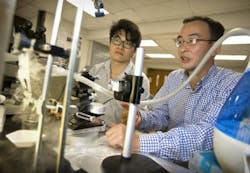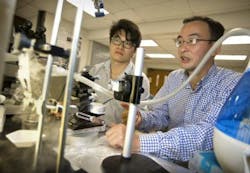Sept. 17, 2014 -- A UT Arlington engineering professor and his doctoral student have recently designed a unique and innovative water-collection device based on a shorebird's beak that can accumulate water from fog and dew. The device could potentially provide water in drought-stricken areas of the world, such as Texas or California, or deserts around the globe.
The idea began when Xin Heng, PhD candidate in the College of Engineering department, saw an article that explained the physical mechanism shorebirds use to collect their food -- driving food sources into their throats by opening and closing their beaks. Cheng Luo, professor in the Mechanical & Aerospace Engineering Department, said that inspired the team to try to replicate the natural beak in the lab.
"We wanted to see if we could do that first," Luo said. "When we made the artificial beaks, we saw that multiple water drops were transported by narrow, beak-like glass plates. That made us think of whether we could harvest the water from fog and dew." Their experiments were successful, as they could harvest about four tablespoons of water in a couple of hours from glass plates that were about 26 centimeters long by 10 centimeters wide.
Shorebirds refers to a general category of bird that lives on the world's shorelines. They typically have long, hinged beaks that are designed to ferret around for prey whether in the sand or the water. Luo noted that the hinged, non-parallel artificial beaks the team made in the lab mimic the shorebirds' beaks, forcing the condensation to the point where the two glass plates meet. The water is pumped through a channel, and then the process is repeated.
Luo and Heng said that more sustainable methods are needed for accumulating water in arid or semi-arid places, which make up about half of the world's land mass. "If this method could be mass-produced, it could be used anywhere in the world fog or dew exist," Luo said. Further, Khosrow Behbehani, dean of the College of Engineering, added, "The research shows innovative ideas can be triggered by careful observation of seemingly unrelated phenomenon. Collecting water from existing fog or dew using this novel method offers another alternative for communities that are strapped for our most precious resource."
See also:
"Dealing with Drought: Making Tough (and Smart) Choices for Overcoming Water Scarcity"
"Drought-stricken West exhausting underground water resources, research shows"
About UT Arlington
The University of Texas at Arlington is a comprehensive research institution of nearly 38,000 students and the second largest institution in The University of Texas System. The Chronicle of Higher Education ranked UT Arlington as the seventh fastest-growing public research university in 2013. U.S. News & World Report ranks UT Arlington fifth in the nation for undergraduate diversity. For more information, visit http://www.uta.edu.
###




